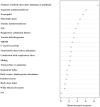Assessment of variables associated with prolonged admission duration in children with Mycoplasma pneumoniae pneumonia
- PMID: 36205104
- PMCID: PMC9629989
- DOI: 10.1111/crj.13549
Assessment of variables associated with prolonged admission duration in children with Mycoplasma pneumoniae pneumonia
Abstract
Introduction: Macrolide-resistant Mycoplasma pneumoniae (MRMP) has become prevalent in children. This study investigated the clinical and laboratory variables of MRMP and macrolide-sensitive M. pneumoniae (MSMP) and identified factors associated with prolonged hospital admission in children.
Methods: A prospective multicenter study was conducted in 1063 children <18 years old in July 2018-June 2020. The 454 had a positive M. pneumoniae polymerase chain reaction assay.
Results: Most subjects had MRMP (78.4%), and all mutated strains had the A2063G transition. We defined MRMP* (n = 285) as MRMP pneumonia requiring admission and MSMP* (n = 72) as MSMP pneumonia requiring admission. Patients with MRMP pneumonia were older, more likely to have segmental/lobar pneumonia, and had more febrile days than those with MSMP pneumonia. C-reactive protein (CRP), lactate dehydrogenase (LDH), and percentage neutrophils were more strongly associated with MRMP* than MSMP* groups. Percentage neutrophils, CRP, and alanine aminotransferase significantly changed between admission and follow-up measurements in patients with MRMP* (P < 0.05). The duration of admission positively correlated with the number of febrile days after initiation of antibiotic medication and laboratory variables (white blood cell count, CRP, and aspartate aminotransferase [AST]) (P < 0.05). Random forest analysis indicated that the number of febrile days after initiation of antibiotic medication, AST, and percentage neutrophils at admission was over five.
Conclusions: This study indicated that children with M. pneumoniae pneumonia with a higher number of febrile days after initiation of antibiotic medication, AST, and percentage neutrophils at admission were more likely to have prolonged admission duration.
Keywords: M. pneumoniae; aspartate aminotransferase; children; macrolide-resistant M. pneumoniae; neutrophil portion.
© 2022 The Authors. The Clinical Respiratory Journal published by John Wiley & Sons Ltd.
Conflict of interest statement
We declare that there are no real or perceived conflicts of interest to declare related with this submission and that we have no links with industry.
Figures



Similar articles
-
Clinical characteristics and associated factors of macrolide-resistant mycoplasma pneumoniae pneumonia in children: a systematic review and meta-analysis.Eur J Clin Microbiol Infect Dis. 2025 Jun;44(6):1505-1522. doi: 10.1007/s10096-025-05101-z. Epub 2025 Mar 19. Eur J Clin Microbiol Infect Dis. 2025. PMID: 40106136
-
Therapeutic efficacy of azithromycin, clarithromycin, minocycline and tosufloxacin against macrolide-resistant and macrolide-sensitive Mycoplasma pneumoniae pneumonia in pediatric patients.PLoS One. 2017 Mar 13;12(3):e0173635. doi: 10.1371/journal.pone.0173635. eCollection 2017. PLoS One. 2017. PMID: 28288170 Free PMC article.
-
Clinical Characteristics of Macrolide-Refractory Mycoplasma pneumoniae Pneumonia in Korean Children: A Multicenter Retrospective Study.J Clin Med. 2022 Jan 8;11(2):306. doi: 10.3390/jcm11020306. J Clin Med. 2022. PMID: 35054002 Free PMC article.
-
Macrolide-Resistant Mycoplasma pneumoniae in the United States as Determined from a National Surveillance Program.J Clin Microbiol. 2019 Oct 23;57(11):e00968-19. doi: 10.1128/JCM.00968-19. Print 2019 Nov. J Clin Microbiol. 2019. PMID: 31484701 Free PMC article.
-
Macrolide-Resistant Mycoplasma pneumoniae Infections in Pediatric Community-Acquired Pneumonia.Emerg Infect Dis. 2020 Jul;26(7):1382-1391. doi: 10.3201/eid2607.200017. Emerg Infect Dis. 2020. PMID: 32568052 Free PMC article.
Cited by
-
Epidemiological and clinical characteristics of hospitalized pediatric patients with Mycoplasma pneumoniae pneumonia before and after the COVID-19 pandemic in China: a retrospective multicenter study.BMC Infect Dis. 2025 Jan 3;25(1):18. doi: 10.1186/s12879-024-10370-8. BMC Infect Dis. 2025. PMID: 39754040 Free PMC article.
-
Clinical characteristics and associated factors of macrolide-resistant mycoplasma pneumoniae pneumonia in children: a systematic review and meta-analysis.Eur J Clin Microbiol Infect Dis. 2025 Jun;44(6):1505-1522. doi: 10.1007/s10096-025-05101-z. Epub 2025 Mar 19. Eur J Clin Microbiol Infect Dis. 2025. PMID: 40106136
-
Epidemiology and surveillance implications of community-acquired pneumonia in children.Clin Exp Pediatr. 2022 Dec;65(12):563-573. doi: 10.3345/cep.2022.00374. Epub 2022 Oct 17. Clin Exp Pediatr. 2022. PMID: 36265520 Free PMC article.
-
Establishment and validation of a predictive model for Lobar pneumonia caused by Mycoplasma pneumoniae infection in children.Sci Rep. 2025 Jul 2;15(1):22811. doi: 10.1038/s41598-025-05548-2. Sci Rep. 2025. PMID: 40594457 Free PMC article.
-
Laboratory diagnosis and treatment of Mycoplasma pneumoniae infection in children: a review.Ann Med. 2024 Dec;56(1):2386636. doi: 10.1080/07853890.2024.2386636. Epub 2024 Aug 3. Ann Med. 2024. PMID: 39097794 Free PMC article. Review.
References
Publication types
MeSH terms
Substances
Grants and funding
LinkOut - more resources
Full Text Sources
Research Materials
Miscellaneous

